By Philip A. Femano, Ph.D. Published on Egyptological, Magazine Edition 2, September 9th 2011.
Please note – click on the images to expand them to view the text and labels.
Introduction

Figure 1. Vertical cross section of the Great Pyramid of Giza showing the main passages and chambers. The rectangle insert shows the region of Fig. 2. The red arrow points to the 3 granite plugs at the bottom of the Ascending Passage. (modified from Piazzi Smyth, Life and Work at the Great Pyramid, Vol.1, Plate 3, 1866).
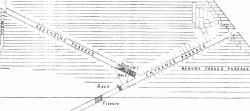
Figure 2. The positioning of 15 feet of granite "plugs" in the northern (lower) end of the Ascending Passage of the Great Pyramid. The main entrance on the north face can be seen at the far right. The northern wall of the Grand Gallery can be seen in the upper left corner. Also depicted is al Mamoun's excavated tunnel and curiously cavernous "hole" at the intersection of the Ascending Passage and Descending Passage. (drawing: Petrie)
The Great Pyramid on the Giza plateau at the apex of the Nile delta is one of the oldest and largest and yet perhaps the most enigmatic manmade structure in recorded history. Egyptologists have determined that it was commissioned by the pharaoh Khufu in the 4th Dynasty of the Old Kingdom to be his royal tomb. Figure 1 shows a vertical cross section indicating the main passages and chambers. The main entrance is on the north face, which leads into the Entrance Passage (“A” in Figure 1), also called the Descending Passage, which terminates at the Subterranean Chamber (“O” in Figure 1). The masonry in the upper structure contains several connected passages and chambers which are in communication with the Descending Passage via the Ascending Passage (“D” in Figure 1). Since the granite box (“I” in Figure 1) that was found in the King’s Chamber (“K” in Figure 1) resembles the size of the traditional sarcophagus (its lack of a mummy, hieroglyphics, or any engraving, notwithstanding), and since the King’s Chamber is preceded by the Antechamber (“H” in Figure 1), it is commonly held that Khufu was entombed in the King’s Chamber.
However, within these passages and chambers are many elements of construction that are difficult to explain within the context of a royal tomb. This article focuses on one such enigma: the set of three massive granite blocks that plug the lower end of the Ascending Passage (see arrow in Figure 1). Those stones are held in place by virtue of a slight narrowing at the end of the Ascending Passage which prevents the blocks from sliding into the Descending Passage.
Each of the three “granite plugs” is 5 feet long and weighs 5 tons. Since they completely block the lower end of the 124 feet long Ascending Passage, the traditional thinking is that they served as a security mechanism to prevent robbers from finding their way into the royal tomb in the King’s Chamber. The “security hypothesis” suggests that after Khufu’s burial ceremony ended, the plugs, which were originally suspended from the vicinity of the Grand Gallery (“GG” in Figure 1) were released at the top of the Ascending Passage and were then pulled by gravity into their current position at the base of the Ascending Passage. There they were caught by the friction generated by the gradual lateral tapering of the limestone passage an instant before the momentum of the plugs would have allowed them to break through the final course of limestone and plunge into the Descending Passage. Figure 2 puts into perspective the relative scale of the granite plugs vis a vis the Ascending Passage and the initial segment of the Descending Passage.
This security hypothesis has been widely accepted, primarily because granite is so much harder, denser, and therefore more impenetrable than limestone, and because the plugs blocked human access to all the passages and chambers in the upper structure, at least during the 4th Dynasty before the Well Shaft was thought to have been breached (“P” in Figure 1). However, there is no evidence that conclusively validates the security hypothesis as representing the true intention of the builders. On the other hand, there are very compelling factors which contradict the security hypothesis.
In determining whether the designers had intended to incorporate a security measure at the lower end of the Ascending Passage, we need to consider whether there might have been another approach that would have placed those plugs more precisely and more securely, allowing them to serve more effectively as a security measure, and if so, an alternative purpose for those stones must be considered.
In this article the evidence that is often cited to support the security hypothesis is challenged.
Positioning the Plugs
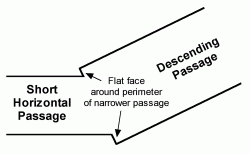
Figure 3. The southern (lower) end of the Descending Passage terminates at the beginning of the short horizontal passage. At this junction, the opening of the horizontal passage is smaller than the Descending Passage, thereby leaving a few inches of facing stone around all four sides of the opening of the horizontal passage. Such a terminus design, if employed at the base of the Ascending Passage, would be effective in precisely controlling the positioning of the granite plugs without the need to jam them less predictably into tapered limestone. (drawing: P.A. Femano)
In the early 1900s, John and Morton Edgar surveyed the lower, southern end of the Descending Passage and documented their findings in Great Pyramid Passages, Volume 1. The terminus of that passage comprises a flat-faced stone through which a smaller opening to the south leads to a short horizontal passage, which in turn leads to the Subterranean Chamber [Figure 3]. It has been proposed by a number of writers that the Subterranean Chamber was the original burial chamber before the builders altered their plans in favor of the King’s Chamber. Had the Subterranean Chamber been the burial chamber, this flat-face surface would have provided precise terminal positioning for a “plug” stone resting at the end of the Descending Passage, thereby blocking access to that chamber. Although plug stones were never reported to have been found at that terminus of the Descending Passage, the Edgars noted significant damage around the perimeter of the opening to the horizontal passage which suggests that something was chiseled out of that opening in order to provide access to the Subterranean Chamber, beyond. This could be interpreted as archeological evidence (albeit circumstantial) that the builders acknowledged such a flat-faced stone might ultimately provide a security function.
Likewise, if the granite plugs in the Ascending Passage truly were intended to be a security mechanism, a similar strategy of providing a flat terminal margin at the bottom of that passage would have allowed more precise control over the plug placement compared to merely relying on the uncertainty of three blocks of stone pulled by gravity into a gradually narrowing passageway which stopped the plugs only as a result of friction along the gradual taper.
Several features of construction within this region of passages in the Great Pyramid that share similar requirements of high precision apparently were prototyped by the builders in a separate construction project located outside the Great pyramid. Petrie discovered a series of passages in the limestone bedrock just east of the pyramid that he called the “Trial Passages”. Since these Trial Passages bear a strong resemblance to the passages within the Great Pyramid’s masonry, they are generally thought to be a prototype of the upper passages of the Great Pyramid. The Trial Passages do include a tapered passage that is similar (yet not identical) to the Ascending Passage. But there is no evidence that the designers conducted such an experiment employing gravity and friction in the Trial Passages, which they might have been expected to do as a way to confirm their calculations of the momentum of the granite plugs before bringing that design into “production”. The lack of evidence that the builders had considered such a security mechanism as part of its prototyping in the Trial Passages can be interpreted to indicate they had no such intentions.
We have no reason to believe that those plugs were deliberately jammed into the tapered passage as an additional security measure. When we consider that the combined weight of the three plugs is around 15 tons and that their hardness of 6.5 mohs certainly would have withstood any excavation technology available to plunderers at that time, it’s hard to imagine what additional security the designers believed such jamming would provide.
Based on the above discussion, it is not conclusive that the builders chose to rely on the unpredictable behavior of gravity on two hewn and unpolished surfaces with different densities and coefficients of friction sliding along each other within a steep tunnel of carved block masonry, as their preferred method of securing a royal burial chamber. Likewise, it is not clear why the builders did not simply seal the pyramid at its main entrance on the north face, sliding the plugs from outside the pyramid into the initial, upper segment of the Descending Passage, capping the plugs with a casing stone, and dissuading anyone from entering the entire pyramid in the first place.
Unless one is to believe that the builders assumed ancient plunderers would stumble on the original entrance, crawl down the unremarkable Descending Passage to reach what appeared to be an “unfinished” Subterranean Chamber and be convinced that there were no other passages to plunder in the Great Pyramid, one is left to wonder why the builders allowed easy passage (or at least such an easy breach) down the Descending Passage at all.
The Prism Stone
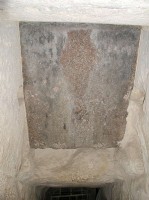
Figure 4. The exposed face of the northernmost granite plug as seen from the Descending Passage looking south and upward. Note the conspicuous difference in appearance between the granite and surrounding limestone. The plug is recessed back into the ceiling of the Descending Passage (yet still protrudes an inch or two into the recessed cavity), and the prism stone is thought to have been fitted into this recess. Also note the small rectangular holes in the upper aspect of the east (left) and west (right) walls of the recess. This is thought to be the primary structural support that held the prism stone in place. For reference, note the iron gate blocking passage to the lower aspect of the Descending Passage at the bottom of the photograph. (Photograph by Jon Bodsworth).
According to the security hypothesis, the conspicuous difference in the appearance of the granite versus the surrounding limestone made it necessary to conceal the exposed granite plug from view in the Descending Passage by covering it with a block of limestone similar to the surrounding masonry [Figure 4]. This covering stone is known as the “prism” stone. The stone gets its name from the vacant, prism-shaped socket in the ceiling of the Descending Passage that the stone is thought to have occupied.
However, the use of the so-called “prism” stone to cover the exposed granite plug as a means to “hide” the plug from view is not well supported by the evidence. To begin with, the prism stone no longer exists. Perhaps the most compelling archeological evidence supporting the existence of the prism stone are the small rectangular indentations in the east and west walls of what is believed to be the prism stone’s vacated socket within the limestone ceiling of the Descending Passage. It has been proposed that those indentations held the stone in place by supporting corresponding nubs extending from the stone itself. It is not clear why the designers would have specified what appears to be unnecessarily small (and obviously insufficient) nubs of stone to support such an important structure. Nor is it clear how such a stone could have been mounted into that socket with nubs fitting into place if the socket was already intact awaiting the installation of the prism stone at the completion of the funerary ceremony.
It is remarkable that there are no reports of anyone ever actually seeing a prism stone in place, or that there are no pictures or drawings depicting any observation of the stone after it had reportedly fallen onto the floor of the Descending Passage, or that there is no artifact available which is thought to be remaining rubble from that stone. Likewise, the historic record only seems to offer the unconfirmed, anecdotal, and rather illogical report from the scientist/explorer Caliph al Mamoun of Baghdad. During his very aggressive excavation through the Great Pyramid in 820 A.D., al Mamoun claimed that the alleged stone made an audible sound when it dropped. And yet even al Mamoun, himself, does not render a firsthand description of the stone. We can only imagine the existence of this legendary stone by virtue of the prismatic cavity that remains in the Descending Passage’s ceiling.
On the other hand, in sharp contrast to the scarcity of archeological evidence of such a stone and the single report by al Mamoun, is the well documented and diligent effort that the original builders exerted to ensure that so many other stress features in that monument were adequately treated. These include:
- the King’s Chamber’s “relieving apartments”
- the King’s Chamber’s granite ceiling blocks which extend a full 5 feet beyond its walls and which weigh up to 70+ tons each
- the Queen’s Chamber’s angled roof blocks which extend farther beyond its walls than within the room ensuring that the center of gravity of each side of the roof is located outside the room
- the girdle stones in the Ascending Passage
- the Grand Gallery’s ceiling blocks which latch into the serrated wall blocks in order to prevent a stress avalanche
Considering the robustness of these measures, we have no reasonable basis to believe that the builders would implement such a flimsy solution to hold up a massive limestone prism block, especially if the block played such an important role in “concealing” the granite as well as the internals of the entire upper structure.
An alternative to the security hypothesis is that the plugs were installed as part of the original structure, placed in situ rather than being slid into place from above, regardless of whether the blocks served a physical or symbolic purpose. This hypothesis contends that the Ascending Passage was never meant to be open physically in the first place. However, that would seem to obviate the need not only for a tapering passage, but also for jamming blocks. Since there would be no reason to design the passage to allow physical access, it would have been possible to design a truly secure system with a more robust solution to secure that ceiling limestone block and ensure that it would not dislodge so easily, as the builders had done at so many other stress points within the pyramid.
Al Mamoun
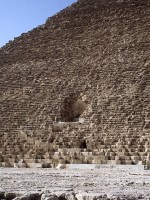
Figure 5. North face of the Great Pyramid showing both the original main entrance and al Mamoun's excavated entrance below and to the right (west) of the main entrance. The main entrance is 24 feet east of the center of the north face while al Mamoun's entrance is at the exact east-west center of the north face. Photograph by Jon Bodsworth (with permission).
Caliph Al Mamoun was the son of Haroun Al-Rashid of “Arabian Nights” fame. He is said to have been very educated in math and science. Having heard stories of treasures that lie deep within the Great Pyramid, al Mamoun embarked on an expedition to Giza. Unable to locate the hidden entrance to the pyramid, al Mamoun allegedly instructed his men to excavate into the north face masonry using copper tools, vinegar and fire to make a tunnel through the limestone blocks with the hopes of stumbling upon the treasures hidden inside [Figures 1 and 2]. In his report of one of the most remarkable “coincidences” in recorded history, al Mamoun claimed that while his men were excavating their tunnel from the north face [Figure 5], the vibrations emanating from their excavations caused the prism stone to fall from its original location in the ceiling of the Descending passage, and they heard the sound of the falling stone so distinctly that they were able to localize the origin of that sound precisely, enabling them to redirect their path of excavation toward that sound, thereby stumbling upon the Descending Passage, the granite plugs, and eventually the Ascending Passage and the rest of the upper structure.
It is difficult to envision how the vibrations that were caused by the excavation activities of al Mamoun’s men, who were located at least 24 feet away from the prism stone through essentially solid limestone, were able to jolt that prism stone out of its position. There have been no reports that the position of any other stone had been disrupted in that region of the pyramid as a result of such vibrations (indeed, Petrie reported that no stones within the entire length of the Descending Passage masonry exhibited a variation from perfect straightness of more than 1/50 of an inch, even at the junction of the masonry and bedrock). Nor were the vibrations strong enough to jostle the upper two granite plugs downward to the bottom plug to close the 4″ gap observed by Petrie a thousand years later – a gap which did close a short time after Petrie reported it.
If the vibrations from al Mamoun’s men were not enough to disrupt the position of any other stone around the prism stone but were enough to dislodge the prism stone from its socket, then this is evidence that the prism stone was the least secured stone of any other stone in that vicinity of the pyramid. It is hardly plausible that what was arguably the most important stone in that part of the pyramid also received the least care in securing its position.
It is equally challenging to explain how al Mamoun’s men could have heard the prism stone drop a mere 4-5 feet onto the floor of the Descending Passage, considering they were most likely working hard, making a lot of their own noise to cause such vibrations as they excavated within the echo chamber of their own tunnel with so much limestone between them and the Descending Passage.
On the other hand, recall that al Mamoun reported that his men essentially stumbled upon a cache of gold that coincidentally equaled the back pay that he owed them. The implication of that account is that al Mamoun planted that gold in order to placate his increasingly hostile workforce. This could easily be interpreted as historic evidence of al Mamoun’s willingness to deceive his audience, giving us a basis to treat the rest of his account only tentatively, at best.
These issues raise some serious doubts about the veracity of al Mamoun’s version of his encounter with the prism stone in particular, and the Great Pyramid in general.
Granite versus Limestone
If a main purpose of the granite plugs was to avert any breaching of the upper structure, then it is not clear why the designers chose a stone that looks conspicuously different than the surrounding stones. If the purpose of the granite plugs was to impose an impenetrable barrier to the upper passageways, then why put much softer limestone adjacent to the granite when plunderers would simply choose to excavate through that softer limestone until they reach the other end of the plugs?
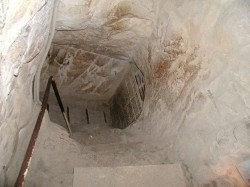
Figure 6. Downward view of al Mamoun's excavated entrance to the Descending Passage. Al Mamoun allegedly excavated this narrow 10 foot long vertical tunnel from his cavernous hole at which point he broke into the Descending Passage (marked by the iron gate) at a location in that Passage that is about 20 feet past the exposed face of the granite plug. The photo shows a downward view to the northeast taken from al Mamoun's hole. The three granite plugs are located above the field of view. It is unclear why al Mamoun would make such a sudden downward, northerly turn from his southbound excavation if he truly did hear the prism stone drop while he was much farther back in his horizontal tunnel before excavating the cavernous hole in the vicinity of the granite plugs. Photograph by Jon Bodsworth (with permission).
It is ironic that the moment al Mamoun saw the exposed face of the first granite plug from his position in the Descending Passage, he immediately assumed it was blocking something important. According to the historic portrayal of al Mamoun’s account, after he heard the stone drop he tunneled toward the sound which led him into the Descending Passage where he noticed the granite plug and suspected that it might be concealing something important, and in short order he tunneled through the limestone around the granite, discovered the Ascending Passage, and the rest of the upper structure. Note that this sequence of events does not tightly correspond to the archeological evidence, such as the inexplicably large dimensions of the tunnel, the cavernous “hole” at the site of the plugs, and the sudden 10 feet drop in the tunnel path elevation before actually connecting with the Descending Passage [Figure 6].
Nevertheless, if the granite plugs were intended to be a security measure, it would have made much more sense to make the plugs out of limestone similar to the surrounding core stone as a more effective camouflage measure, instead of granite. If anything, the use of an obviously different stone draws attention to it rather then deflecting attention away from it. And if al Mamoun was truly the first to breach the Great Pyramid since the time of Khufu, this so-called “security” mechanism was a complete failure the very first time it was put to the test.
It is difficult to accept that the designers were that incompetent in light of other fine work in the Great Pyramid that indicates they were quite capable of implementing much more formidable structural components.
Ancillary Considerations
Having considered the available evidence, the true purpose of those granite blocks remains unclear and may not be revealed until we also can provide reasonable explanations for at least the following:
1. the fact that the Ascending Passage is inexplicably so much longer (124′) than the length of those three short granite plugs (15′ total length),
2. Petrie’s observation of a four inch gap between the lower and middle plug in a cascade of three blocks weighing 5 tons each which purportedly slid down the Ascending Passage with tremendous force in order to secure the upper structure,
3. the cause of the severe damage to the upper (southern) aspect of the last plug (Petrie estimates the upper 24 inches of that plug are missing),
4. the composition, purpose, and origin of the cement on the floor located two feet farther up the Descending passage from the broken end of the uppermost plug, which Petrie claimed included a piece of granite from that plug, evidence which strongly contradicts the notion that the plugs slid down from the Grand Gallery after all humans had evacuated,
5. the reason for cementing the uppermost plug in place when the plugs’ collective weight was around 15 tons bearing down toward the base of the Ascending Passage,
6. the cause of the dilapidated condition of all the walls along the segment of the Ascending Passage immediately south of the granite plugs,
7. the lack of any plausible location where those three plugs were “stored” during a royal funerary ceremony,
8. a method for securing/releasing each of the five ton granite plugs thereby enabling them to slide down the Ascending Passage without causing human entrapment, and,
9. the open access to the Grand Gallery from the subterranean Descending Passage via the Well Shaft which clearly obviates any “security” function proposed for the granite plugs.
Conclusion
If the designers truly intended to incorporate a “security” measure at the lower aspect of the Ascending Passage, then it is much more likely that the builders would have designed a system which, at the very least,
- ensured more precise control over where the plugs were positioned,
- used limestone instead of granite for more effective camouflage, and,
- employed a more robust method of installing the prism stone.
The currently available data seem to indicate that the granite plugs were unsuitable as a security measure and likely served a different purpose. More research and analysis is required to understand the true nature of the intersection of the Ascending Passage and Descending Passage beyond the historically popular hypothesis.
Dr. Femano can be contacted at origyptian {at} micinfo {dot} com.
Bibliography and Additional Reading
For information about the construction of the Great Pyramid based on early direct observations, drawings and photographs (i.e., pre-restoration), see
Smyth, Piazzi, 1880, Our Inheritance in the Great Pyramid
Petrie, WMF, 1883, Temples and Pyramids of Gizeh
Edgar, John and Morton, 1906, Great Pyramid Passages
Figure Credits
Figure 1. Modified from Piazzi Smyth, Life and Work at the Great Pyramid, Vol.1, Plate 3, 1866.
Figure 2. Drawing by Sir William Flinders Petrie
Figure 3. Drawing by the author, P.A. Femano
Figure 4. Photograph by Jon Bodsworth (with permission)
Figure 5. Photograph by Jon Bodsworth (with permission)
Figure 6. Photograph by Jon Bodsworth (with permission)
 By
By